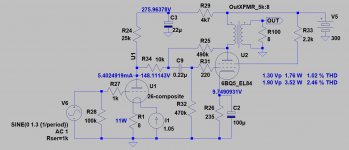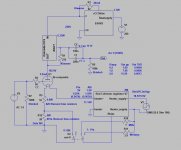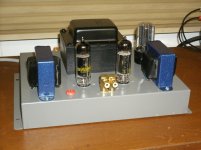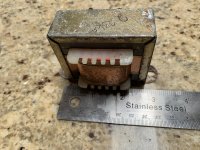My 2 cents:
I think 6V6 is more linear and sounds nicer than El84. Within max Pd you will not get more than 1.5watt in triode mode, period. Also I don't think you need any more than 1.5watt for your HF driver. Since you have plenty of drive from your source/pre whatever, any of the above discussed dht will do the job. So far filament bias sounds best to my ears. You should try that. Since taste/listening room/system in the chain are always unique, you can not determine beforehand which solution you will like most.
Request you to bite the bullet and start building and report back, from this we will be benefited also. 100 pages of discussion is no use if no building the project. Start simple build the amp listen carefully, if the like it upgrade to:
Filament bias
filament regulator
plate chokes/CCs/Gyrator (for plate load)
Triode mode/Pentode mode for el84/6v6
FB/no FB
etc.
VT 52 once realized he is not listening to music rather complecating his building/projects. And he sadly refrain himself from the hobby for quite some time. I like your original idea of a small SE amp with dht driver.
Please pay attention to good grounding scheme and really really good power supply. if these two things are not good enough nothing will make your amp a good one.
Regards
Yes, it is time to start building. I have a spare pair of unassembled Coleman filament regulators, and I have all the tubes and parts I need to get started. I will put together a breadboard with the sockets I need and and try a bunch of things out. I'll start with the power supply on a separate bread board. I'll probably build a separate supply for the power and driver tubes. I will start with the 01A and 26 tubes, and the circuits provided by Euro21 and andyjevans in this thread, and on the Bartola site. I'll post schematics as I go along.
If you don't hate tube top caps, 2C22 is an alternative solution.
Thanks for all the schematics that you have done, and for the tube suggestions. I would like to start with tubes I have at hand, and I have the 01A and 26 that andyjevans likes best. Would you be so kind to do a couple more schematics with these tubes? Since I have your schematic for the 27, and since I have so many of them, I'll do that as well and listen to how it sounds.
The simplest version with 26 driver (filament biased with R.C. regulator).
I'm curious..... what do resistors R25 and R34 add to the circuit?
Thanks for the schematic. I have a Rod Coleman’s regulated filament supply to use, but I’m not sure how that fits in with a “filament biased with R.C. regulator”. What is L1? I have looked into filament regulators such as the Coleman ones that I have on hand, but I don’t know anything about filament bias with a regulator. I’ll do some research.
but I don’t know anything about filament bias with a regulator.
Maybe this helps a little.
Attachments
I'm curious..... what do resistors R25 and R34 add to the circuit?
Wouldn't R25/R32 be plate to grid feedback for V2?
edit: or R25/R32||V1+R34
Last edited:
Wouldn't R25/R32 be plate to grid feedback for V2?
edit: or R25/R32||V1+R34
I don't know - never seen this before. That's why I asked why it's there. I couldn't see a reference in the RH84 thread. Maybe somebody could explain?
I'm guessing it applies to the output stage in pentode and would be dropped if the output stage was in triode?
"I don't know - never seen this before. That's why I asked why it's there. I couldn't see a reference in the RH84 thread. Maybe somebody could explain?
I'm guessing it applies to the output stage in pentode and would be dropped if the output stage was in triode?''
Schade feedback, that's it + some tweaking done by EURO21. In triode mode it's not needed. Since this amp is meant for HF driver triode mode EL84/6V6 is good enough.
Regards
I'm guessing it applies to the output stage in pentode and would be dropped if the output stage was in triode?''
Schade feedback, that's it + some tweaking done by EURO21. In triode mode it's not needed. Since this amp is meant for HF driver triode mode EL84/6V6 is good enough.
Regards
Like Andy, I've also been working on building an SET using a DHT driving an IDHT.
Unlike Andy, my builds are relatively unsophisticated, simple, low parts count and low budget, using junkbox parts (especially transformers) whenever possible.
My current breadboard project uses a 26 driving a 6N6G. This thing sounds amazing. A very nice combination.
I've had some 26s for a while but hadn't tried them due to all the posts about problems with them being microphonic and prone to hum. To my surprise I'm not having any problems at all with them.
The 6N6G is a somewhat obscure output tube that consists of two dissimilar triodes. The input triode is configured as a cathode follower so its plate is connected directly to the B+. It's directly connected internally to the output triode. The bias is all done internally too, so the cathode pin connects directly to ground. Power output is ~4w, so just a bit higher than a 2A3.
I'm using a PT that I scrounged from a derelict Webcor reel to reel recorder I found years ago. The OTs, which were found on eBay, came from a Voice of Music SE 6BQ5 console stereo amp. They're not the ideal load for the 6N6Gs so I'm probably not getting a full 4w of output.
I'm using a cheap (under $10) Meanwell SMPS with an added LC section to heat the 26s. The plates are choke loaded using the cheap Hammond 156Cs and regulated with a 0A2. They're fixed biased using a 9v Lithium battery.
I've attached the schematics.
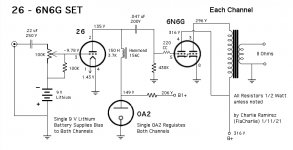
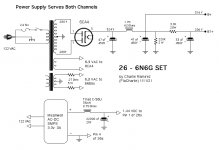
Ooops . . . looks like I forgot to label the resistor on the 0A2 plate. It's a 2k 5w.
As I mentioned, the OTs I'm using in this were originally used on a SE Voice of Music console amp. I recently reworked one of them. I left it in pentode mode in order to get as much power out at possible. The console used a separate preamp section so the stock NFB was disconnected and I wanted to be able to use the amp section with whatever preamp I wanted, so I used local NFB.
I'm all about copy and paste, since I'm not much of a designer. I suppose you could take the 26 front end and drop it in front of the SE 6BQ5.
I've also attached a pic and schematic of that project.
[/ATTACH]
Unlike Andy, my builds are relatively unsophisticated, simple, low parts count and low budget, using junkbox parts (especially transformers) whenever possible.
My current breadboard project uses a 26 driving a 6N6G. This thing sounds amazing. A very nice combination.
I've had some 26s for a while but hadn't tried them due to all the posts about problems with them being microphonic and prone to hum. To my surprise I'm not having any problems at all with them.
The 6N6G is a somewhat obscure output tube that consists of two dissimilar triodes. The input triode is configured as a cathode follower so its plate is connected directly to the B+. It's directly connected internally to the output triode. The bias is all done internally too, so the cathode pin connects directly to ground. Power output is ~4w, so just a bit higher than a 2A3.
I'm using a PT that I scrounged from a derelict Webcor reel to reel recorder I found years ago. The OTs, which were found on eBay, came from a Voice of Music SE 6BQ5 console stereo amp. They're not the ideal load for the 6N6Gs so I'm probably not getting a full 4w of output.
I'm using a cheap (under $10) Meanwell SMPS with an added LC section to heat the 26s. The plates are choke loaded using the cheap Hammond 156Cs and regulated with a 0A2. They're fixed biased using a 9v Lithium battery.
I've attached the schematics.


Ooops . . . looks like I forgot to label the resistor on the 0A2 plate. It's a 2k 5w.
As I mentioned, the OTs I'm using in this were originally used on a SE Voice of Music console amp. I recently reworked one of them. I left it in pentode mode in order to get as much power out at possible. The console used a separate preamp section so the stock NFB was disconnected and I wanted to be able to use the amp section with whatever preamp I wanted, so I used local NFB.
I'm all about copy and paste, since I'm not much of a designer. I suppose you could take the 26 front end and drop it in front of the SE 6BQ5.
I've also attached a pic and schematic of that project.
[/ATTACH]
Attachments
Last edited:
The plates are choke loaded using the cheap Hammond 156Cs and regulated with a 0A2. They're fixed biased using a 9v Lithium battery.
I have a pair of unlabeled chokes that my LCR meter won't measure because their inductance is too great. I have a choke here with inductance small enough to measure that measures 38.61H on the meter, and I put it in parallel with the unlabelled choke and got a parallel inductance measurement of 34.78H. Using an inductors in parallel calculator online, I worked out that the inductance of the choke I can't measure normally is 350H. Does that make sense?
The calculation makes sense but are you sure both figures are in H and not mH?I have a pair of unlabeled chokes that my LCR meter won't measure because their inductance is too great. I have a choke here with inductance small enough to measure that measures 38.61H on the meter, and I put it in parallel with the unlabelled choke and got a parallel inductance measurement of 34.78H. Using an inductors in parallel calculator online, I worked out that the inductance of the choke I can't measure normally is 350H. Does that make sense?
I don't have a lot of experience with chokes but I would think that either one of those would be physically huge. If they're not they're probably rated for very low current and may not be useful in tube gear. How do they measure for DCR?
Can you post a pic of them?
FlaCharlie: Thanks for the schematics. I like to use what I have at hand whenever possible, and I don't have the 156C, but they are $15.41 CAD each at my favourite supplier, so not too painful.
That's a really good price for the 156C. I usually get stuff from Digi-Key because they have a free shipping option (which also applies to Canada).
Free Shipping On Parts Orders | Audiokarma Home Audio Stereo Discussion Forums
That's about what they get for them in USD. What supplier do you use? Perhaps they're cheaper there because they're produced in Canada.
Last edited:
FlaCharlie: The 156C is actually $15.71 USD, and $18.02 CAD. I thought I was in Canadian pricing when I looked it up. I buy all my Hammond stuff from A1 Electronic Parts in Toronto. They are usually cheaper than anywhere else here. I’m not sure what shipping will do to the price as they don’t have free shipping. I have attached a photo of the choke. One of them has a disconnected lead wire that needs repair. They weigh 27.7 ounces each.
Attachments
- Home
- Amplifiers
- Tubes / Valves
- DHT driver for triode wired SE EL84, 6V6 or EL34
